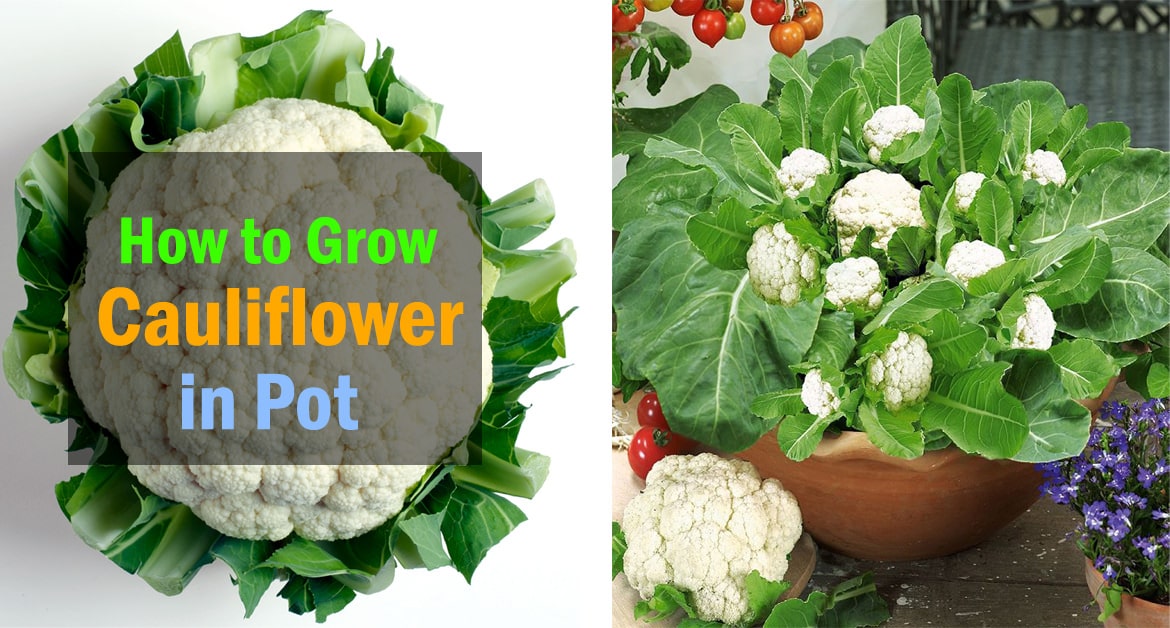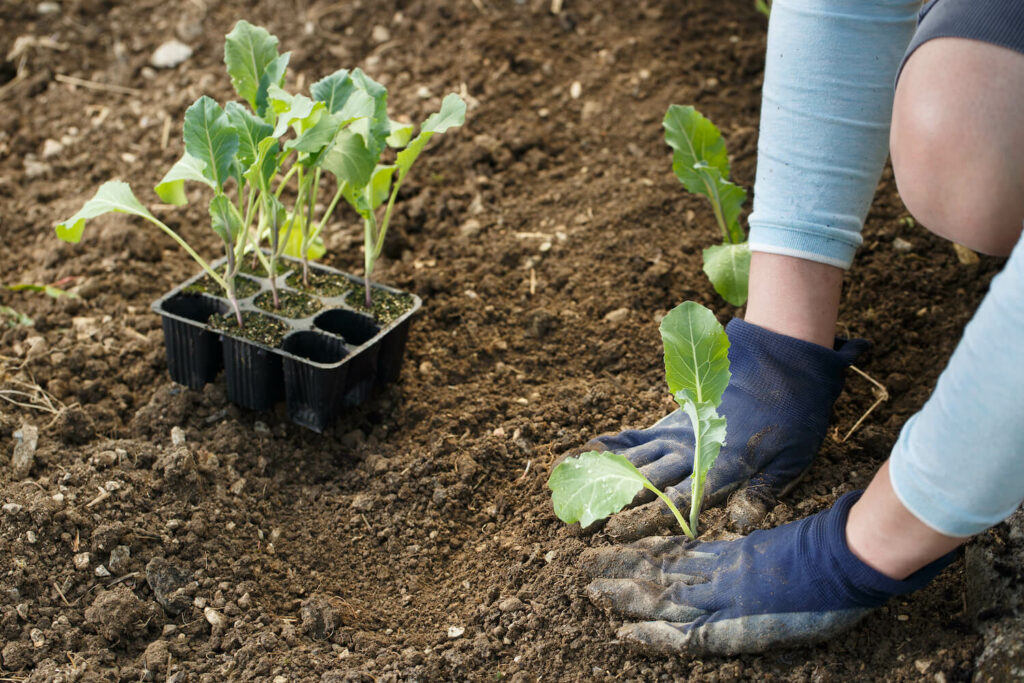As a horticulture student I mainly studied crops and cultivation techniques. It fascinates me how many diverse plants can grow from small, nearly identical seeds. Favourite fruit: blueberries, grapes, raspberries, pears Favourite vegetables: mushrooms, peppers, kohlrabi, onions, garlic
Cauliflower has a bit of reputation among hobby gardeners for being a tricky vegetable to grow. If you keep a few tips in mind, you will find yourself successfully growing your own cauliflower in no time!
Cauliflower (Brassica oleracea var. botrytis) is a member of the Brassicaceae family and looks similar to broccoli (Brassica oleracea var. italica). It is easy to digest, contains many valuable nutrients and has a subtle flavour. Just like with broccoli, you can eat the flower head of a cauliflower. Find out all about where and how to grow cauliflower yourself as well as which plants make the best cauliflower companion plants.
Cauliflower is a cool-season vegetable that produces dense, compact heads of edible florets. While it’s commonly grown directly in the ground, did you know you can also successfully grow cauliflower in pots? With the right conditions and care, container gardening is a great option for this tasty brassica.
Why Grow Cauliflower in Pots?
There are several benefits to growing cauliflower in containers:
-
Control over soil quality: Potting soil blends drain better than in-ground soil. Cauliflower needs consistently moist (but not wet) soil. Container gardening allows you to provide ideal moisture levels.
-
Accessibility: Pots can be moved for protection from intense sun and heat. The plants are also easier to monitor for pests, disease, and harvest time.
-
Lack of space If you don’t have an in-ground garden, container gardening allows you to grow cauliflower on a balcony, patio, or deck.
-
Blanching ease Blanching cauliflower heads by tying leaves over them is simpler with potted plants,
-
No rotation required Rotating brassica crops yearly is recommended to prevent disease in garden beds. With containers you skip this step.
Choosing a Container
Cauliflower has a shallow root system. Focus on container width over depth:
-
Minimum depth of 8 inches.
-
Minimum width of 12 inches for one plant, wider for multiple plants. Allow 18-24 inches between plants.
-
Material: Plastic, metal, ceramic, cement, or wood. Include drainage holes.
-
Terra cotta dries out quickly, so watch soil moisture closely. Reduce watering in heavy pots like ceramic or cement.
Cauliflower Varieties for Containers
Some top cauliflower varieties for container gardening include:
-
Early White: Quick 55-65 day maturity. Large self-blanching leaves.
-
Cheddar: 70-75 day orange hybrid. No blanching needed.
-
Depurple: Vibrant purple 7-inch heads. No need to blanch.
-
Flame Star: Heat tolerant orange hybrid. 60 day maturity.
-
Snowball Improved: 60-65 day heirloom. Self-blanching.
How to Plant Cauliflower in Pots
Location: Choose a spot with 6+ hours of sun. Move pots to adjust for temperature.
Timeframes: Spring or fall when temperatures are cool (below 75°F). Time plantings based on variety maturation rate.
Potting mix: Use lightweight, commercial potting mix with good drainage.
Planting:
-
Direct sow seeds 1/2 inch deep, 2-3 inches apart. Thin seedlings.
-
Start seeds indoors 4-6 weeks before last spring frost, 8-10 weeks before first fall frost. Harden off and transplant outside.
-
Gently transplant nursery starts into soil-filled pots. Water and fertilize.
Caring for Container Cauliflower
Water: Check soil moisture daily. Water when top few inches become dry. Avoid soggy soil.
Sun: Place in full sun, provide afternoon shade if temperatures exceed 75°F.
Fertilizer: Apply balanced fertilizer every 2 weeks according to label instructions.
Blanching: When heads reach golf ball size, tie leaves loosely over them to block sunlight.
Pests: Check for aphids, cabbage loopers, flea beetles. Use row covers, beneficial insects, appropriate sprays.
Diseases: Avoid overwatering and crowding plants to prevent fungal issues like damping off.
Bolting: Can be caused by heat, drought stress, or cold. Shelter pots and keep consistently moist.
Harvest: Cut heads when tight and firm. Use a sharp knife to cut stalk just below the head.
With the right pot, soil, and care, cauliflower can be grown successfully in containers. Pay close attention to sunlight, water, and fertilization. Shelter from heat and cold as needed. Control pests promptly. Blanch heads for best quality. If given ideal conditions, you can enjoy homegrown cauliflower from patio pots!

Cauliflower Care in Pots
Place the container where the cauliflower receives at least six hours of sunlight per day. Water the plant until water runs through the drainage hole whenever the soil feels dry to the touch. Don’t water if the potting mix is still damp because plants can rot quickly in soggy soil. However, never allow the mix to become bone dry. Check the container every day, as soil in containers dries quickly, especially during hot, dry weather.
Feed the cauliflower monthly, using a balanced, water-soluble fertilizer. Alternatively, mix a dry, time-release fertilizer into the potting mix at planting time.
Your plants may need a little help to ensure the vegetables are tender and white when you’re ready to harvest. This process, known as “blanching,” simply involves protecting the heads from direct sunlight. Some varieties of cauliflower are “self-blanching,” which means the leaves curl naturally over the developing head. Watch the plants carefully when the heads are about 2 inches (5 cm.) across. If the leaves aren’t doing a good job at protecting the heads, help them along by pulling the large, outside leaves up around the head, then secure them with a piece of string or a clothespin.
You want to know who’s behind Plantura?


As a horticulture student I mainly studied crops and cultivation techniques. It fascinates me how many diverse plants can grow from small, nearly identical seeds. Favourite fruit: blueberries, grapes, raspberries, pears Favourite vegetables: mushrooms, peppers, kohlrabi, onions, garlic
Cauliflower has a bit of reputation among hobby gardeners for being a tricky vegetable to grow. If you keep a few tips in mind, you will find yourself successfully growing your own cauliflower in no time!

Cauliflower (Brassica oleracea var. botrytis) is a member of the Brassicaceae family and looks similar to broccoli (Brassica oleracea var. italica). It is easy to digest, contains many valuable nutrients and has a subtle flavour. Just like with broccoli, you can eat the flower head of a cauliflower. Find out all about where and how to grow cauliflower yourself as well as which plants make the best cauliflower companion plants.
Growing Cauliflower in Containers | Tips, When to Harvest & More!
FAQ
How big of a container do I need for cauliflower?
-
Minimum Size:A container with a width of at least 12 inches and a depth of 12 inches is recommended for a single cauliflower plant.
-
Larger Containers:If you plan to grow multiple plants, increase the width accordingly, allowing 18-24 inches between plants, or use multiple pots.
-
Drainage:Ensure the container has adequate drainage holes to prevent waterlogging.
-
Potting Mix:Use a well-draining potting mix, as cauliflower plants need good aeration for their root systems.
-
Spacing:If you are planting multiple plants, space them 18-24 inches apart.
-
Location:Place the pots in a location with afternoon shade, as cauliflower does not like extreme heat, and potted plants are especially exposed.
-
Watering:Water the plants regularly to keep the soil evenly moist, in hot summer weather this might require daily watering.
-
Fertilizing:Cauliflower is a heavy feeder, so increase the fertilizer frequency, feeding the plant every two weeks with a fertilizer diluted to half strength.
-
Mulch:Apply organic mulch to help keep the soil cool and moist and suppress weeds.
Does cauliflower grow well in containers?
Any type of container will work, but be sure it has at least one good drainage hole in the bottom, as your cauliflower plants will rot quickly in soggy soil.
How long does it take for cauliflower to grow in pots?
- Cauliflower typically takes about 70 to 100 days from planting to harvest, depending on the variety and growing conditions.
- Variety: Different cauliflower varieties have different maturity periods.
- Growing Conditions: Factors like temperature, soil quality, and water availability can impact the growth rate.
Why is cauliflower difficult growing?
Cauliflower doesn’t like warm weather, especially not when it’s trying to produce a head. This preference for cool weather is one of the things that makes cauliflower a little difficult to grow. Your cauliflower plant needs at least 70 days of temps between 45 and 80°F to complete its growth.
Can you grow cauliflower in containers?
Growing your own cauliflower can be a challenge, but by planting your crop in containers, you make it easier to control their growing environment. Keep your plants happy and healthy and you have a good chance of finding a beautiful head waiting for you under the leaves at harvest time. Just remember: water, water, water.
How to grow cauliflower in a pot?
Tips For Growing Cauliflower Your container should have a diameter of 12 inches and depth of 12 inches. The ones measuring between 16 to 18 inches are ideal for growing cauliflower. You can store your pots in a place experiencing 50 to 80 degrees Fahrenheit temperature. This should be done if you are aiming for a fall crop.
How many cauliflower plants can you grow in a pot?
If you have a larger pot, such as a half-whiskey barrel, you can grow up to three plants. Any type of container will work, but be sure it has at least one good drainage hole in the bottom, as your cauliflower plants will rot quickly in soggy soil.
When should I plant cauliflower?
Plant seedlings about a month before the last average frost date if you want to harvest cauliflower in spring. For a fall crop, plant seedlings about six weeks before the last average frost in your area. Place the container where the cauliflower receives at least six hours of sunlight per day.
Can you grow cauliflower in a garden?
Cauliflower cannot usually be seen in home gardens. However, it can be grown easily just like other garden vegetables. It has similar health benefits as that of other green veggies like cabbage and broccoli. It is rich in fibre, vitamin C and other cancer-fighting compounds. This cruciferous vegetable is well suited in cool weather.
Can you plant cauliflower seeds indoors?
Never use garden soil, which quickly becomes compacted and prevents air from reaching the roots. You can start cauliflower seeds indoors about a month before the average frost in your climate, or you can plant seeds directly outdoors in the container when temperatures are about 50 degrees F. (10 C.).
